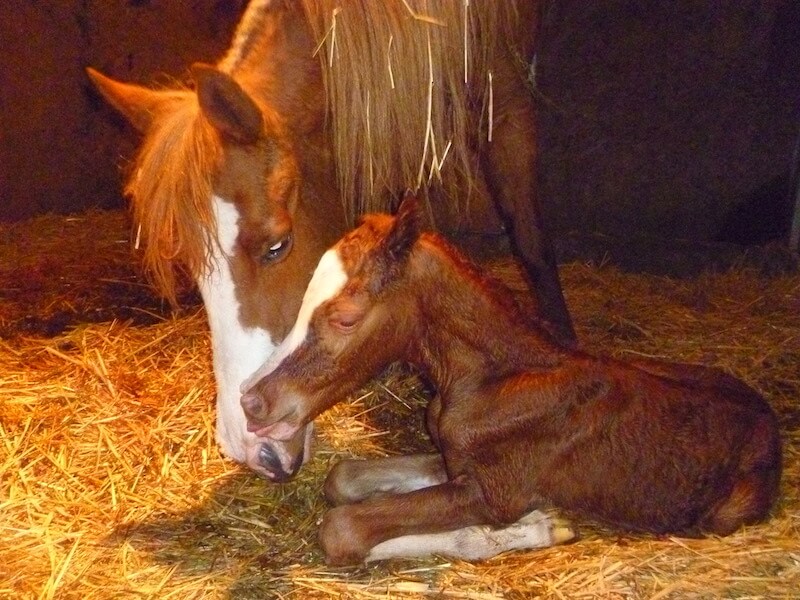What to Look for After Your Mare Foals
by Brandi Holohan, DVM

This is the day; you have waited 11 long months and your mare has delivered her foal. It took about 20 to 30 minutes from her water breaking to her delivering the foal. It is generally advised that if the mare is actively colicky or laboring for greater than 30 minutes, you should consult your horse’s veterinarian. Now what? The foal and mare are still lying on the stall floor, staring at each other and trying to figure out what just happened. The first few hours of the relationship between mare and foal are extremely important for bonding.
The mare generally stands up within 15 minutes of delivery, and the tension on the umbilical cord will cause it to tear about 1 inch from the foal’s abdomen. The vessels in the cord are stretched, and this results in contraction and clotting. The placenta is sometimes passed immediately but more commonly will hang from the mare’s vulva for a short time. The umbilical stump on the foal’s belly should be dipped in antiseptic—dilute chlorhexidine, three times the first day, twice the second and once the third day. If the umbilicus does not stop bleeding within a few minutes, or if it doesn’t break away from the placenta, you can tie it with dental floss or a clean shoe lace about 1 inch from the abdomen, cut off any excess (leave half an inch to an inch on the opposite side of the tie), and consult your veterinarian.
My general rule of thumb is a 1-2-3 rule. The foal should stand within one hour and nurse within two hours, and the mare should pass her placenta within three hours. It is a really good idea to set the placenta aside for the veterinarian to inspect for completeness and any abnormalities. A retained placenta is an emergency.
Maiden mares often have a more difficult time adjusting to a nursing foal. She may squeal and not let it nurse well. You may need to offer her some reassurance and restrain her to allow the foal to nurse. If the mare was dripping milk for more than one hour prior to foaling, you should consult your veterinarian. The foal needs to consume the colostrum/first milk from the mare in order to be able to absorb the antibodies that are essential for survival. If the mare loses the colostrum prior to nursing, or the foal does not consume an adequate amount within the first six to eight hours, it may be at risk of life-threatening infection.
Your veterinarian typically draws a blood sample when the foal is about 18 to 24 hours of age to assess this antibody level, the IgG level. I highly recommend that this test be performed to give you the peace of mind that the level is adequate and the foal does not require a plasma transfusion.
Look your new foal over carefully, from nose to tail. The nostrils should be clear of any debris. If you notice any milk coming from the nostrils, call your vet. This may indicate a problem with the foal’s palate or its ability to swallow. The upper and lower jaw should be in good alignment and the gums should be pink (not red). Look at the foal’s eyes. A new foal may have suffered some blood vessel rupture during the foaling process and the eyes may look red around the edges. Discharge from the eyes, cloudiness, swelling or holding the eyes closed is cause for concern. The ears should be upright and alert. The legs should be strong and without angular deformities. The umbilicus should be checked for a hernia, swelling, any continued bleeding or urine drainage. The foal should pass a blackish stool called meconium within the first 12 to 18 hours of life. Contact your veterinarian if the foal appears to be in discomfort or has not passed meconium.
Foals should be full of energy and nurse with vigor and frequency. If your foal seems dull or lethargic, it is an emergency and may indicate serious illness. Call your veterinarian with any questions and concerns. He or she may need to perform a thorough mare and foal exam and can offer support as you and your mare welcome this new life into the world.

Dr. Holohan graduated from Wisconsin College of Veterinary Medicine in 2000 and, after a one-year, post-doctoral internship, joined Pilchuck’s team of equine ambulatory doctors in July 2001where her special interest has been mare and stallion reproductive management. Her continuing education in this area has been a major asset to the services offered at Puget Sound Equine Reproduction Center. Dr. Holohan has also furthered her skills in equine dentistry and offers full services to clients both in hospital and in the field. On her weekends off, Dr. Holohan continues to enjoy outdoor activities with her husband, two sons, and their two Jack Russell terriers. For more information on Pilchuck’s reproductive services visit www.pilchuckvet.com.
Published April 2012 Issue

The Colorado Horse Source is an independently owned and operated print and online magazine for horse owners and enthusiasts of all breeds and disciplines in Colorado and surrounding area. Our contemporary editorial columns are predominantly written by experts in the region, covering the care, training, keeping and enjoyment of horses, with an eye to the specific concerns in our region.

